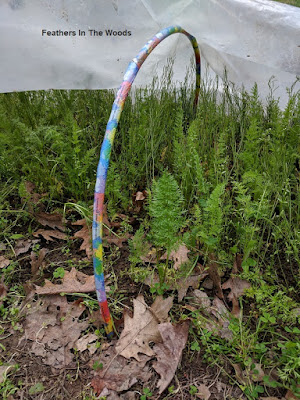I have a very quick and easy way to protect them that costs only a few dollars and can be thrown together in minutes. You only need plastic, some braces and something to hold the plastic down on the edges so it doesn't get blown off. The best part is, you can buy almost all your supplies at the dollar store! How's that for frugal gardening?
Cheap low tunnel DIY
For the past few years I've been making a hoop house style low tunnel to protect my seedlings. To help it hold its form I use hula hoops from the dollar store. I hold it down on the sides with pieces of board or bricks. It only costs a few dollars to make, can be reused many times and stores easily in between uses.
The low tunnel in the picture actually held up all winter as I put it over my carrots so they could overwinter. They did absolutely wonderful even though it was a small and cheap hoop house. By the end of the third winter the plastic had a few tears in it, but it still worked to protect my carrots from frost and deer!
To make a simple small hoop house:
4 hula hoops from the dollar store
Serrated knife for cutting hoops
Roll of 9 ml plastic or clear plastic drop cloth
Scissors for cutting plastic
Make a cut through the hula hoop to open it up. You'll need to pour out the beads if there are some inside. Pull gently on each end to open up the hoop and decide how large you want the tunnel to be. I made another cut and removed about 6" from the hoop. You'll want to size it to your plants though.
Once cut, place the hoops into the ground about a foot apart. You can leave a lot more space between them if they're only going in for a short time. Place the braces closer together if you're expecting snow though, since the weight will try to pull it down.
Cover with a sheet of plastic and cut to fit, leaving about a foot extra on each side. You want enough room to place boards or stones on it to hold it down. If you're expecting snow or want to leave this up for any length of time, use the rolls of plastic from the hardware store. If you're just throwing this up for a night or two to protect from a light frost, get a clear plastic drop cloth from the dollar store.
Now I did use the one in the next picture all winter long, however it was more as an experiment. I wanted to see if it would hold up. It did, but a quick hoop house like this one from Two Branches Homestead would probably be a better choice for overwintering!
Since we're just using this one to avoid losing seedlings to a late frost, you won't need to actually build a frame. Just toss this together real quick when the weather report calls for frost and leave it in till the danger had passed.
Once the weather has warmed up, remove the plastic and hoops and store them to next time. See, it was easy and cheap... Wasn't it?
Related reading: Want more information on organic gardening? Check out this collection of articles on gardening.
~L
Want gardening and healthy living information sent right to your email weekly? Click right here to join my newsletter list and get new posts sent directly to you the day they're published!





I have done the same thing by purchasing used wooden or aluminum screens at Habitat for Humanity or yard sales. They can be leaned against each other (like a teepee), use a twist tie or small bungie to connect at the top, and then put your plastic over it. If you don't want the screens, cut them out and it makes a great frame. I stack the frames in the winter. You can use smaller screens for low growing veggies and get the taller ones for tomatoes, etc. Either way, it is a cheap way to save the veggies in the spring or late fall. Love your suggestions and newsletter! Rita
ReplyDelete